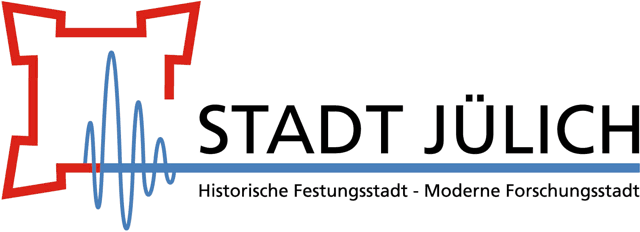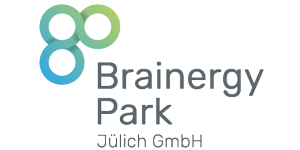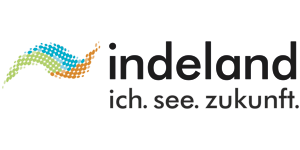Mersch
Coat of arms of Mersch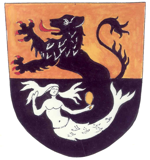 |
The coat of arms shows a black lion in a golden field in the upper part and a silver mermaid holding a golden mirror in the lower part. |
Municipal administrator: Konrad Eskens Am Driesch 7a 52428 Jülich phone: +49 (0)2461 52521 |
| Location in the Jülich region: |
| Mersch is located in the North of the city of Jülich near the motorway BAB A 44. It is surrounded by Broich in the West, Sevenich in the North, Serrest in the East and Pattern in the Southeast.Broich is located North of the city of Jülich in the valley and at the slope of the Northeastern riverside of the river Rur near the motorway BAB A 44. It is surrounded by Barmen and Koslar in the West, by Tetz and Boslar (city of Linnich) in the North and by Mersch in the East. |
| History |
|
The village name Mersch stems from the word “Maar” (a circular recess filled with water). Mersch emerged from 2 settlement centres, the village of Kerzich or Kirzenich (the name has not been mentioned anymore since the 16th century) and Mersch. Kirzenich is mentioned in a deed of Archbishop Anno II of Cologne in 1071/75. Mersch has been mentioned for the first time at the beginning of the 16th century. The environment of Mersch was a hill moor through which ran the only road to Cologne. The main road of Mersch is the “Alte Reichsstraße”. It commemorates the Reichsstraße 1 (Aachen – Königsberg) which ran through the region of Jülich and through Mersch. It mainly followed the route of a very old trade route from the Belgian coast of the North Sea to the Russian city of Novgorod. |
| Administrative affiliation |
| Until the end of the Holy Roman Empire, Mersch belonged to the office of Jülich. In French times, it briefly was a canton and mairie. As part of the Prussian Rhine Province, Mersch was added to Jülich and became a mayor’s office in 1867. |
| "Merscher Höhe" |
| The “Merscher Höhe” in the South of Mersch was the starting point of the conquests of the citadel of Jülich in the years 1610 as well as 1621/22. |
| Transmitting station “Merscher Höhe” |
| In 1956, a transmitting installation with radio masts of a height of up to 103 m was erected near Mersch for the Deutsche Welle (German radio station). From this installation, today, more than 100 providers transmit their radio programmes all over the world. |
| Associations |
| Carnival society “Bretzelbäckere” Mersch-Pattern e.V.; Kraftsport-Club Pattern-Mersch e.V.; fire-fighting group Mersch of the Freiwillige Feuerwehr Jülich (volunteer fire brigade); SV Mersch 1924 e.V.; St. Sebastianus Schützenbruderschaft Mersch-Pattern e.V. (rifle club); TTC Mersch-Pattern e.V(www.juelich.de/Vereine) |
| Points of interest |
||
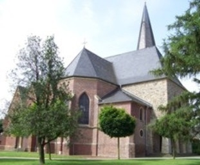 St. Agatha of Mersch -view from the Southeast St. Agatha of Mersch -view from the Southeast |
The church St. Agatha was originally a chapel belonging to Güsten and received parish rights around 1550. The church was built in the 15th century, extended and modified in 1913 and re-erected according to original plans in 1946/47 after destruction during the war. |
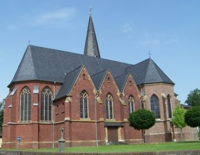 St. Agatha of Mersch - view from the Southwest St. Agatha of Mersch - view from the Southwest |
| The high altar is a work of the Antwerp School and was created around 1520. The middle part of the altar figuratively presents the crucifixion and the wings show pictures of the martyry of Saint Agatha. |
||
-
03 Jul 2025
Gemeinsam gegen fehlende Klinikbetten und viel zu lange Wartezeiten
Die Stadt Bedburg, die allgemeinmedizinische Praxis Dr. med. Wasserberg und das Krankenhaus Jülich kooperieren im neuen Medizinischen Versorgungsverbund Erft-Rur
More -
03 Jul 2025
L228: Durchfahrt zwischen Jülich-Merzenhausen und Aldenhoven wegen Sturmschäden gesperrt
Voraussichtlich bis 07./08.07.2025
More -
03 Jul 2025
Museum Kreativ 2025
Kulturrucksack: Kreativangebot für Kinder und Jugendliche am 15. und 16.07.2025
More -
02 Jul 2025
-
02 Jul 2025
All news
